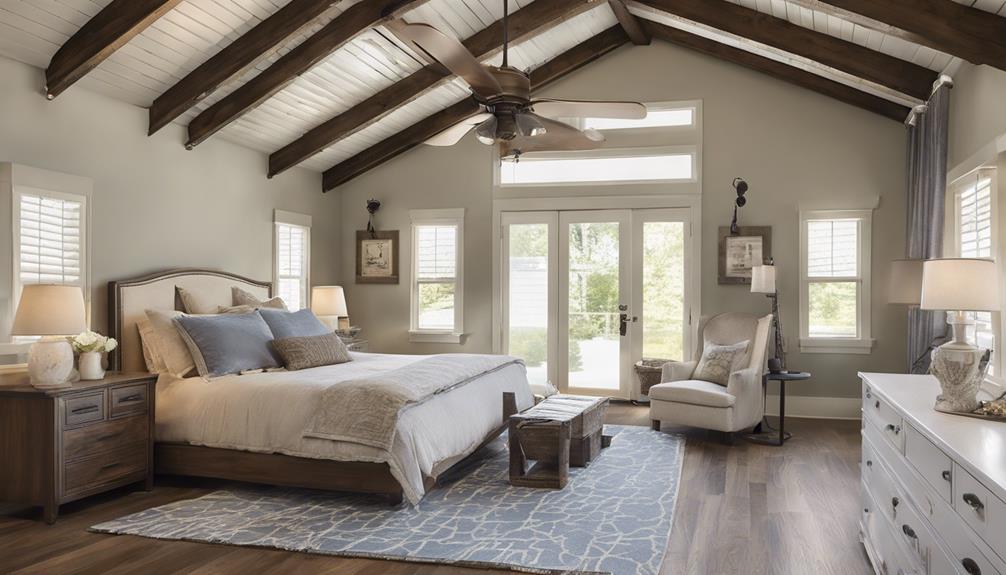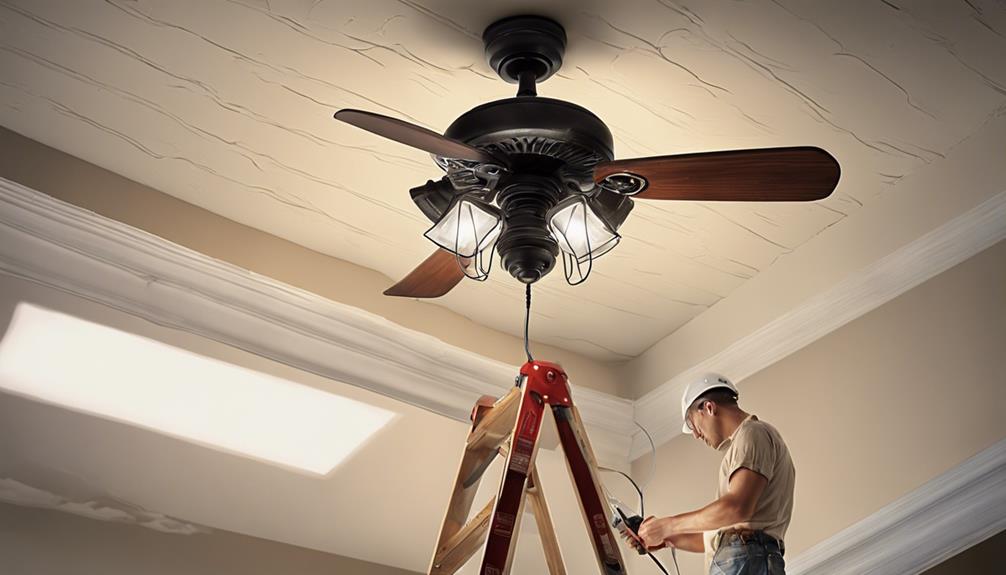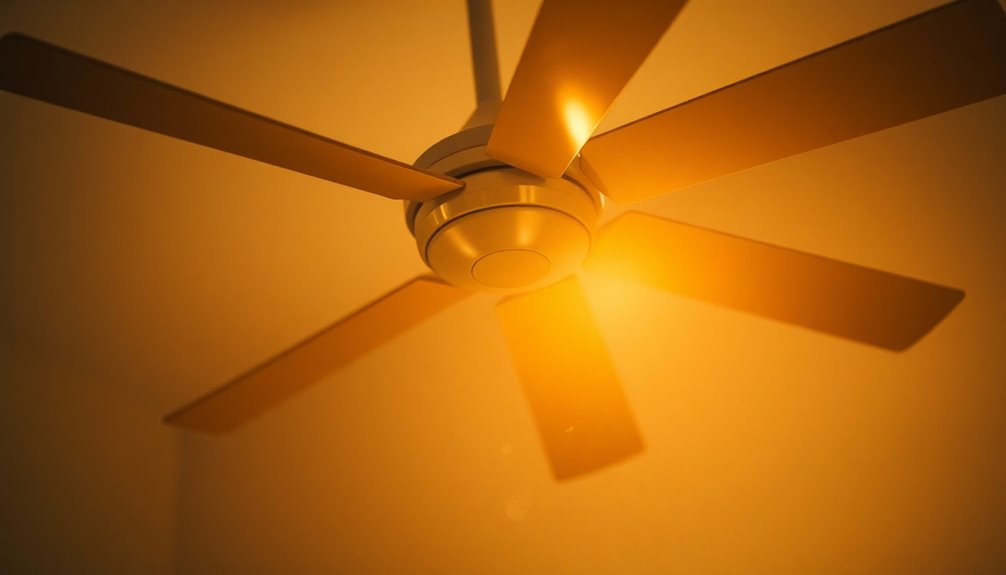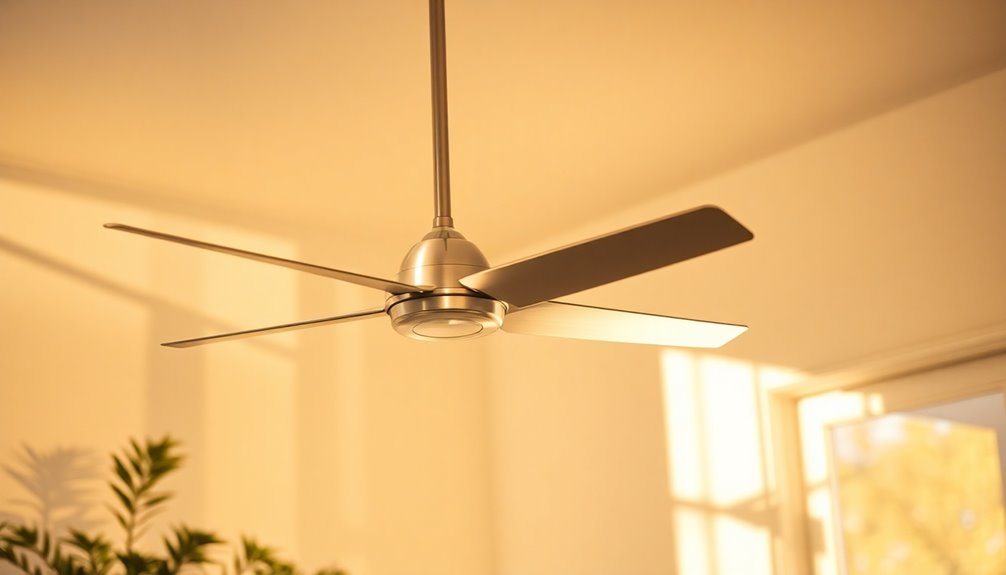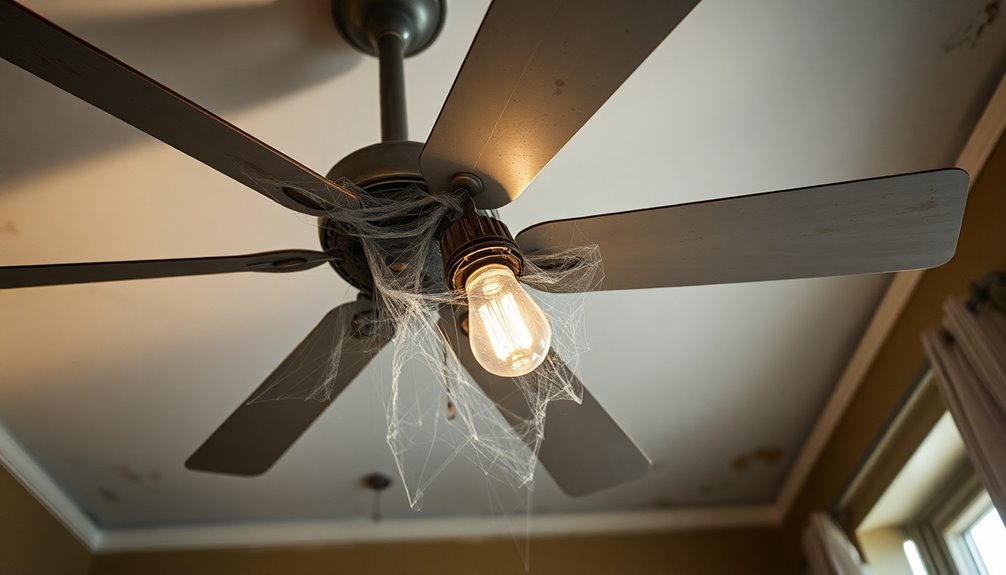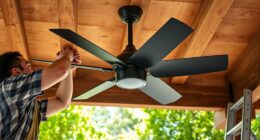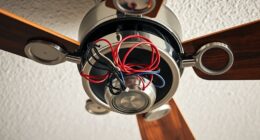I recommend having ceiling fans in bedrooms to improve sleep quality, regulate temperature, and promote a relaxing atmosphere. In living rooms, consider ceiling fans for better air circulation, aesthetic appeal, and reduced reliance on AC. For dining areas, ceiling fans enhance ambiance, prevent odors, and contribute to energy efficiency. Home offices benefit from improved air circulation, a comfortable workspace, and energy savings with ceiling fans.
Kitchens can see advantages like even heat distribution, condensation prevention, and enhanced functionality with ceiling fans. If you want to know more about where to install ceiling fans for optimal benefits in various rooms, keep in mind the specific needs and functionalities of each space.
Key Takeaways
- Bedrooms benefit from improved sleep quality and airflow regulation.
- Living rooms can enjoy enhanced air circulation and temperature control.
- Dining areas benefit from improved ambiance and air circulation.
- Home offices can have better air circulation and temperature regulation.
- Kitchens can improve air circulation, heat distribution, and lighting with ceiling fans.
Benefits of Having Ceiling Fans in Bedrooms
Having a ceiling fan in your bedroom can significantly improve your sleep quality by providing comfortable airflow. The gentle breeze created by ceiling fans helps regulate the temperature, making it easier to fall and stay asleep. Not only does this airflow prevent stuffiness, but it also promotes a relaxing atmosphere conducive to a restful night.
Additionally, using ceiling fans in bedrooms can lead to energy savings by reducing the need for air conditioning, especially during milder seasons. By utilizing ceiling fans year-round, you can enhance comfort in your bedroom regardless of the weather outside. The proper air circulation provided by ceiling fans ensures that your bedroom remains a cozy sanctuary where you can unwind and recharge.
Considerations for Installing Ceiling Fans in Living Rooms

When considering installing ceiling fans in living rooms, it's important to factor in the size of the room, the aesthetic appeal of the fan, and how effectively it can improve air circulation.
These aspects play a significant role in determining the comfort and efficiency of the ceiling fan in the living space. By carefully evaluating these points, one can make informed decisions to maximize the benefits of having a ceiling fan in the living room.
Living Room Size
Considering living room size is crucial when determining the appropriate ceiling fan for optimal air circulation and comfort.
Installing a ceiling fan in a living room with a size of 225 to 400 square feet is ideal for efficient airflow.
Choose a ceiling fan with a blade span of 52 to 56 inches to ensure proper air distribution.
Ceiling fans can help reduce the reliance on air conditioning systems by circulating cool air effectively.
Proper placement of ceiling fans in living rooms enhances overall cooling efficiency and comfort.
Aesthetic Appeal
To enhance the aesthetic appeal of a living room, selecting a ceiling fan that complements the space's style and décor is key. A well-chosen ceiling fan can serve as both a functional and decorative element, adding elegance and sophistication to the room.
Consider opting for ceiling fans with stylish finishes and designs that align with the overall theme of your living room. Additionally, integrated lighting features in ceiling fans can elevate the ambiance of the space, creating a warm and inviting atmosphere.
Air Circulation
Enhancing air circulation in living rooms through the installation of ceiling fans is essential for maintaining a comfortable and well-ventilated environment.
Ceiling fans work by creating air movement, helping to distribute cool air efficiently.
The cooling effect provided by ceiling fans can contribute to a more pleasant atmosphere for relaxation and social gatherings.
Proper placement of ceiling fans in living rooms ensures that air is circulated evenly throughout the space.
Using ceiling fans in living rooms can reduce the need for constant air conditioning use, leading to energy savings and a more sustainable living environment.
Importance of Ceiling Fans in Dining Areas

Ceiling fans play a crucial role in dining areas by enhancing the ambiance, improving air circulation, and providing energy efficiency benefits.
The gentle breeze generated by ceiling fans can create a more comfortable and inviting atmosphere for enjoying meals with family and friends.
Additionally, proper air circulation from ceiling fans helps prevent stagnant air and cooking odors, contributing to a fresher dining environment.
Dining Ambiance Enhancement
During meals, the gentle breeze provided by ceiling fans in dining areas enhances the ambiance, creating a more enjoyable dining experience.
- The airflow from ceiling fans can help disperse cooking odors and maintain a pleasant dining environment.
- Using ceiling fans in dining rooms can improve air circulation and prevent stagnant air.
- Ceiling fans with dimmable lights can create a cozy atmosphere for dining occasions.
- Energy-efficient ceiling fans in dining areas can contribute to overall comfort and cost savings.
Air Circulation Improvement
Improving air circulation in dining areas is essential for creating a comfortable and pleasant dining experience. Installing ceiling fans can help distribute cool air more effectively, preventing stagnant air pockets and ensuring a refreshing atmosphere during meals.
The ventilation provided by ceiling fans not only disperses cooking odors but also reduces the need for excessive air conditioning, ultimately saving on energy costs. By enhancing air circulation, ceiling fans in dining rooms complement the overall design while serving a practical purpose in enhancing comfort.
With these fans in place, the dining area becomes a welcoming space where the air feels fresh and inviting, making every meal more enjoyable and satisfying.
Energy Efficiency Benefits
Enhancing the energy efficiency of dining areas, ceiling fans play a crucial role in creating a comfortable and cost-effective environment for meals.
- Ceiling fans in dining areas can help distribute cool air, reducing the need for constant air conditioning and saving money on energy bills.
- Properly placed ceiling fans enhance air circulation, improving cooling efficiency without directly affecting room temperature.
- By incorporating ceiling fans in dining areas, you can enjoy a cooling breeze during meals, enhancing overall comfort.
- Using ceiling fans in your home's dining area is a smart way to save money on energy costs while maintaining a pleasant atmosphere for your family gatherings.
Practicalities of Ceiling Fans in Home Offices

In a home office setting, the practicality of ceiling fans lies in their ability to improve air circulation and create a more comfortable working environment. Properly placed ceiling fans can help regulate temperature, preventing stagnant air and enhancing productivity by providing a cooling breeze during work hours.
Using ceiling fans in home offices can reduce the need for air conditioning, leading to energy savings. Additionally, installing a ceiling fan in a home office contributes to a more ergonomic and pleasant workspace.
Advantages of Ceiling Fans in Kitchens

Ceiling fans in kitchens offer numerous benefits, ranging from improved air circulation to enhanced lighting options. When considering installing a ceiling fan in your kitchen, here are some advantages to keep in mind:
- Improved air circulation: Ceiling fans can help keep the air in your kitchen fresh by circulating it effectively, reducing cooking odors and improving ventilation.
- Enhanced heat distribution: The airflow from a ceiling fan can distribute heat more evenly throughout the kitchen, making it more comfortable to cook, especially in areas prone to temperature fluctuations.
- Prevention of condensation buildup: Using a ceiling fan in the kitchen can help prevent condensation buildup, particularly near stoves and sinks, which can lead to moisture-related issues.
- Additional lighting: Ceiling fans with lights can provide extra illumination in the kitchen, enhancing visibility while preparing meals, creating a warm and inviting atmosphere.
Incorporating a ceiling fan in your kitchen can't only improve the air quality and ventilation but also enhance the overall functionality and ambiance of the space.
Factors to Keep in Mind for Ceiling Fans in Outdoor Spaces

Considering the outdoor setting, it's crucial to prioritize safety by selecting UL-listed ceiling fans designed for damp or wet locations. When choosing an outdoor ceiling fan, take into account the size of the area to ensure proper air circulation, promoting a comfortable environment. Opt for fans with rust-resistant finishes to withstand outdoor elements such as rain and humidity effectively. Installing ceiling fans in outdoor spaces not only enhances airflow but also helps in reducing heat buildup, making it more pleasant for relaxation and entertainment outdoors.
Additionally, these fans can also deter insects, allowing you to enjoy outdoor activities without disturbances. By investing in a suitable outdoor ceiling fan, you can create a welcoming and enjoyable outdoor space while ensuring safety and durability against the elements. Remember, a well-chosen ceiling fan can significantly improve your outdoor experience.
Frequently Asked Questions
Which Rooms Need a Ceiling Fan?
I believe living rooms and kitchens definitely benefit from ceiling fans. They help distribute cool air and maintain a comfortable environment.
Bathrooms and hallways mightn't need ceiling fans as much, but I can see how a ceiling fan could be useful in a dining area or an office space.
Ultimately, it's about personal preference and creating a space that's tailored to your comfort needs.
Where Not to Put Ceiling Fans?
I'd avoid putting ceiling fans in kitchens due to potential hazards, like interfering with hanging items or grease buildup. Bathrooms are also a no-go, as the moisture can damage the fan and pose electrical risks.
In the living room, consider how the fan's design fits the aesthetic to prevent it from clashing with the overall look. It's important to assess these factors before installing ceiling fans in these areas.
Are Bedrooms Supposed to Have Ceiling Fans?
Bedrooms are the perfect spot for ceiling fans to boost airflow, enhance sleep comfort, and offer cooling solutions.
The gentle breeze can create a soothing environment, preventing stuffiness and promoting energy savings by reducing the need for air conditioning.
It's a practical addition that can significantly improve the overall sleep experience.
Where Are the Best Places to Put a Ceiling Fan?
I believe the best places to put a ceiling fan include the kitchen for cooling, bathrooms to combat humidity, and living rooms for overall comfort.
By strategically placing ceiling fans in these areas, you can enhance air circulation, improve temperature regulation, and create a more pleasant environment.
This allows for better airflow, reduces stuffiness, and enhances the overall ambiance of these spaces.
Why Should Bedrooms Have Ceiling Fans and Which Ones are the Quietest?
Having top quiet bedroom fans is essential for a comfortable and restful night’s sleep. Ceiling fans not only help circulate the air but also provide white noise to drown out any external sounds. Look for models with DC motors and aerodynamic blades for the quietest operation.
Conclusion
In the dance of home comfort and efficiency, ceiling fans play a vital role. From bedrooms to kitchens, these silent guardians provide a gentle breeze and energy savings.
So, whether you're looking to add a touch of style or improve air circulation, consider installing ceiling fans in the rooms where you spend the most time. Let the rhythm of their blades bring harmony to your living spaces.
